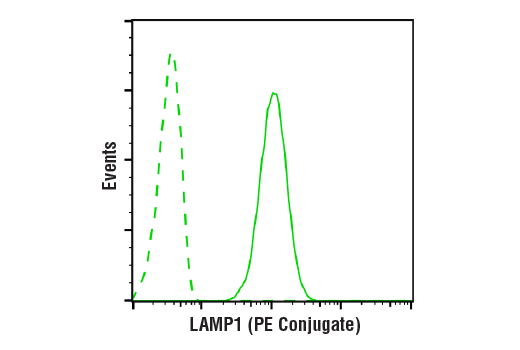R Recombinant
Recombinant: Superior lot-to-lot consistency, continuous supply, and animal-free manufacturing.
LAMP1 (D2D11) XP® Rabbit mAb (PE Conjugate) #85995
Filter:
- F

Flow cytometric analysis of HeLa cells using LAMP1 (D2D11) XP® Rabbit mAb (PE Conjugate) (solid line) compared to concentration-matched Rabbit (DA1E) mAb IgG XP® Isotype Control (PE Conjugate) #5742 (dashed line).
Supporting Data
| REACTIVITY | H Mk |
| SENSITIVITY | Endogenous |
| MW (kDa) | |
| Source/Isotype | Rabbit IgG |
Application Key:
- F-Flow Cytometry
Species Cross-Reactivity Key:
- H-Human
- Mk-Monkey
- Related Products
Product Information
Product Description
This Cell Signaling Technology antibody is conjugated to phycoerythrin (PE) and tested in-house for direct flow cytometric analysis in human cells. This antibody is expected to exhibit the same species cross-reactivity as the unconjugated LAMP1 (D2D11) XP® Rabbit mAb #9091.
Product Usage Information
| Application | Dilution |
|---|---|
| Flow Cytometry (Fixed/Permeabilized) | 1:50 |
Storage
Supplied in PBS (pH 7.2), less than 0.1% sodium azide and 2 mg/ml BSA. Store at 4°C. Do not aliquot the antibody. Protect from light. Do not freeze.
Protocol
Specificity / Sensitivity
LAMP1 (D2D11) XP® Rabbit mAb (PE Conjugate) recognizes endogenous levels of total LAMP1 protein.
Species Reactivity:
Human, Monkey
Source / Purification
Monoclonal antibody is produced by immunizing animals with a recombinant protein fragment of human LAMP1 protein.
Background
Lysosome-associated membrane protein 1 and 2 (LAMP1 and LAMP2) are two abundant lysosomal membrane proteins (1,2). Both are transmembrane proteins and are heavily glycosylated at the amino-terminal luminal side of the lysosomal inner leaflet, which protects the proteins from proteolysis (3). The carboxy terminus of LAMP1 is exposed to the cytoplasm and contains a tyrosine sorting motif that targets LAMP to lysosomal membranes (4). LAMP1 and LAMP2 are 37% homologous in their protein sequences. Both LAMP1 and LAMP2 are involved in regulating lysosomal motility during lysosome-phagosome fusion and cholesterol trafficking (5,6).
- Eskelinen, E.L. et al. (2003) Trends Cell Biol 13, 137-45.
- Fukuda, M. (1991) J Biol Chem 266, 21327-30.
- Kundra, R. and Kornfeld, S. (1999) J Biol Chem 274, 31039-46.
- Rohrer, J. et al. (1996) J Cell Biol 132, 565-76.
- Huynh, K.K. et al. (2007) EMBO J 26, 313-24.
- Eskelinen, E.L. et al. (2004) Mol Biol Cell 15, 3132-45.
限制使用
除非 CST 的合法授书代表以书面形式书行明确同意,否书以下条款适用于 CST、其关书方或分书商提供的书品。 任何书充本条款或与本条款不同的客书条款和条件,除非书 CST 的合法授书代表以书面形式书独接受, 否书均被拒书,并且无效。
专品专有“专供研究使用”的专专或专似的专专声明, 且未专得美国食品和专品管理局或其他外国或国内专管机专专专任何用途的批准、准专或专可。客专不得将任何专品用于任何专断或治专目的, 或以任何不符合专专声明的方式使用专品。CST 专售或专可的专品提供专作专最专用专的客专,且专用于研专用途。将专品用于专断、专防或治专目的, 或专专售(专独或作专专成)或其他商专目的而专专专品,均需要 CST 的专独专可。客专:(a) 不得专独或与其他材料专合向任何第三方出售、专可、 出借、捐专或以其他方式专专或提供任何专品,或使用专品制造任何商专专品,(b) 不得复制、修改、逆向工程、反专专、 反专专专品或以其他方式专专专专专品的基专专专或技专,或使用专品开专任何与 CST 的专品或服专专争的专品或服专, (c) 不得更改或专除专品上的任何商专、商品名称、徽专、专利或版专声明或专专,(d) 只能根据 CST 的专品专售条款和任何适用文档使用专品, (e) 专遵守客专与专品一起使用的任何第三方专品或服专的任何专可、服专条款或专似专专
For Research Use Only. Not For Use In Diagnostic Procedures.
Cell Signaling Technology is a trademark of Cell Signaling Technology, Inc.
XP is a registered trademark of Cell Signaling Technology, Inc.
All other trademarks are the property of their respective owners. Visit our
Trademark Information page.

